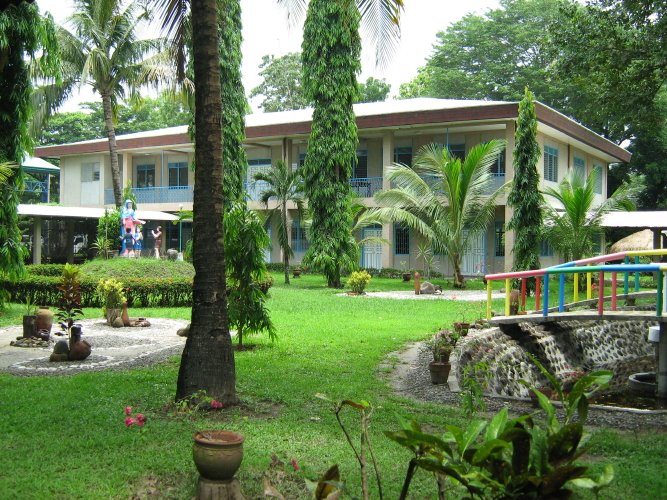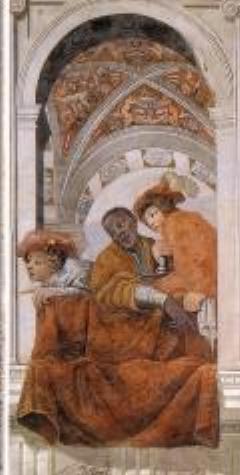|
San Martino, Velletri
San Martino Vescovo is a Roman Catholic church located in the historic center of Velletri, in the province of Rome, in Italy. A church at the site is mentioned in a bull from 1065 from Pope Alexander II. The church was assigned to the Somaschi Fathers in 1616 by Pope Paul V Pope Paul V (; ) (17 September 1552 – 28 January 1621), born Camillo Borghese, was head of the Catholic Church and ruler of the Papal States from 16 May 1605 to his death, in January 1621. In 1611, he honored Galileo Galilei as a mem .... Over the centuries, the church has undergone reconstruction. Under the Somaschi, it was rebuilt in 1772 to 1778 with the facade completed in 1825. The altarpiece of the ''Madonna with Child'' was brought here in 1817 from the abandoned Monastery of Santa Maria dell’Orto.Official website of the parish at http://www.psmartinov.it/ . References Churches in Velletri Roman Catholic churches in Lazio Neoclassical architecture in Lazio 19th-century Roman Cath ... [...More Info...] [...Related Items...] OR: [Wikipedia] [Google] [Baidu] |
Roman Catholic
The Catholic Church (), also known as the Roman Catholic Church, is the largest Christian church, with 1.27 to 1.41 billion baptized Catholics worldwide as of 2025. It is among the world's oldest and largest international institutions and has played a prominent role in the history and development of Western civilization. O'Collins, p. v (preface). The church consists of 24 ''sui iuris'' (autonomous) churches, including the Latin Church and 23 Eastern Catholic Churches, which comprise almost 3,500 dioceses and eparchies around the world, each overseen by one or more bishops. The pope, who is the bishop of Rome, is the chief pastor of the church. The core beliefs of Catholicism are found in the Nicene Creed. The Catholic Church teaches that it is the one, holy, catholic and apostolic church founded by Jesus Christ in his Great Commission, that its bishops are the successors of Christ's apostles, and that the pope is the successor of Saint Peter, upo ... [...More Info...] [...Related Items...] OR: [Wikipedia] [Google] [Baidu] |
Velletri
Velletri (; ; ) is an Italian ''comune'' in the Metropolitan City of Rome, approximately 40 km to the southeast of the city centre, located in the Alban Hills, in the region of Lazio, central Italy. Neighbouring communes are Rocca di Papa, Lariano, Cisterna di Latina, Artena, Aprilia, Lazio, Aprilia, Nemi, Genzano di Roma, and Lanuvio. Its motto is: ('Liberty of pope and empire is given to me'). Velletri was an ancient city of the Volsci tribe. Legendarily it came into conflict with the Romans during the reign of Ancus Marcius, the fourth king of Rome; then again in the fifth and fourth centuries BCE, during the early Roman Republic. Velletri was also the home of the Octavia gens, Octavii, the paternal family of the first Roman Emperor Augustus. In the Middle Ages, it was one of the few "Free Imperial City, free cities" in Lazio and central Italy. It was the site of two historic battles in 1744 and 1849. During the Second World War, it was at the centre of fierce fighting betw ... [...More Info...] [...Related Items...] OR: [Wikipedia] [Google] [Baidu] |
Province Of Rome
The province of Rome () was one of the five provinces that formed part of the Lazio region of Italy. It was established in 1870 and disestablished in 2014. It was essentially coterminous with the Rome metropolitan area. The city of Rome was the provincial capital. During the 1920s, the boundary of the province shrank as land was ceded to establish new provinces. The province of Rome was the most populous province in Italy. On 1 January 2015, it was superseded by a new local government body—the Metropolitan City of Rome Capital. - provincia.roma.it History Prior to 1870, the area of the province was the |
Pope Alexander II
Pope Alexander II (1010/1015 – 21 April 1073), born Anselm of Baggio, was the head of the Roman Catholic Church and ruler of the Papal States from 1061 to his death in 1073. Born in Milan, Anselm was deeply involved in the Pataria reform movement. 1061 papal election, Elected according to the terms of his predecessor's bull, ''In nomine Domini'', Anselm's was the first election by the cardinals without the participation of the people and minor clergy of Rome. He also authorized the Norman Conquest, Norman Conquest of England in 1066. Early life and work Anselm was born in the parish of Cesano Boscone in the town of Corsico some from Milan of a noble family. The family took its name from Baggio (district of Milan), Baggio, a suburb of Milan, where the family held the office of "captain". According to the ''Liber pontificalis'', his father's name was Anselmus or Ardericus. Contemporary sources do not provide any information on where Anselm might have obtained his education ... [...More Info...] [...Related Items...] OR: [Wikipedia] [Google] [Baidu] |
Somaschi Fathers
The Somaschi Fathers, also known as the Somascans and officially as the Order of Clerics Regular of Somasca (), are a Catholic Church, Catholic order of Cleric regular, Clerics Regular of Pontifical Right for men. It was founded in Italy in the 16th century by Jerome Emiliani and named after the motherhouse at Somasca. , 517 Somascans served around the world. They provide staff for boys' homes, serve in 95 parishes, and engage in other ministries. History In 1532, the priests Alessandro Besuzio and Agostino Bariso joined the charitable labors of Jerome Emiliani, a converted former soldier from Venice. Emiliani founded the religious order called the "Company of the Servants of the Poor" in 1534, calling together his collaborators and companions for a general assembly. This handful of laymen and priests adopted an organized structure for the movement of religious and social reform started by Jerome in 1529 in Venice. In the rule of this congregation, Emiliani stated the princi ... [...More Info...] [...Related Items...] OR: [Wikipedia] [Google] [Baidu] |
Pope Paul V
Pope Paul V (; ) (17 September 1552 – 28 January 1621), born Camillo Borghese, was head of the Catholic Church and ruler of the Papal States from 16 May 1605 to his death, in January 1621. In 1611, he honored Galileo Galilei as a member of the papal Accademia dei Lincei and supported his discoveries. In 1616, Pope Paul V instructed Cardinal Robert Bellarmine to inform Galileo that the Copernican theory could not be taught as fact, but Bellarmine's certificate allowed Galileo to continue his studies in search for evidence and use the geocentric model as a theoretical device. That same year Paul V assured Galileo that he was safe from persecution so long as he, the Pope, should live. Bellarmine's certificate was used by Galileo for his defense at the trial of 1633. Trained in jurisprudence, Borghese was made Cardinal-Priest of Sant'Eusebio and the Cardinal Vicar of Rome by Pope Clement VIII. He was elected as Pope in 1605, following the death of Pope Leo XI. Pope ... [...More Info...] [...Related Items...] OR: [Wikipedia] [Google] [Baidu] |
Churches In Velletri
Church may refer to: Religion * Church (building), a place/building for Christian religious activities and praying * Church (congregation), a local congregation of a Christian denomination * Church service, a formalized period of Christian communal worship * Christian denomination, a Christian organization with distinct doctrine and practice * Christian Church, either the collective body of all Christian believers, or early Christianity Places United Kingdom * Church, a former electoral ward of Kensington and Chelsea London Borough Council that existed from 1964 to 2002 * Church (Liverpool ward), a Liverpool City Council ward * Church (Reading ward), a Reading Borough Council ward * Church (Sefton ward), a Metropolitan Borough of Sefton ward * Church, Lancashire, England United States * Church, Iowa, an unincorporated community * Church Lake, a lake in Minnesota * Church, Michigan, ghost town Arts, entertainment, and media * ''Church magazine'', a pastoral theology magazine ... [...More Info...] [...Related Items...] OR: [Wikipedia] [Google] [Baidu] |
Roman Catholic Churches In Lazio
Roman or Romans most often refers to: *Rome, the capital city of Italy *Ancient Rome, Roman civilization from 8th century BC to 5th century AD *Roman people, the people of Roman civilization *Epistle to the Romans, shortened to Romans, a letter written by Paul, found in the New Testament of the Christian Bible * Ar-Rum (), the 30th sura of the Quran. Roman or Romans may also refer to: Arts and entertainment Music * Romans (band), a Japanese pop group * ''Roman'' (album), by Sound Horizon, 2006 * ''Roman'' (EP), by Teen Top, 2011 *"Roman (My Dear Boy)", a 2004 single by Morning Musume Film and television *Film Roman, an American animation studio * ''Roman'' (film), a 2006 American suspense-horror film * ''Romans'' (2013 film), an Indian Malayalam comedy film * ''Romans'' (2017 film), a British drama film * ''The Romans'' (''Doctor Who''), a serial in British TV series People * Roman (given name), a given name, including a list of people and fictional characters *Roman (surname) ... [...More Info...] [...Related Items...] OR: [Wikipedia] [Google] [Baidu] |
Neoclassical Architecture In Lazio
Neoclassical or neo-classical may refer to: * Neoclassicism or New Classicism, any of a number of movements in the fine arts, literature, theatre, music, language, and architecture beginning in the 17th century ** Neoclassical architecture, an architectural style of the 18th and 19th centuries ** Neoclassical sculpture, a sculptural style of the 18th and 19th centuries ** New Classical architecture, an overarching movement of contemporary classical architecture in the 21st century ** in linguistics, a word that is a recent construction from Neo-Latin based on older, classical elements * Neoclassical ballet, a ballet style which uses traditional ballet vocabulary, but is generally more expansive than the classical structure allowed * The "Neo-classical period" of painter Pablo Picasso immediately following World War I * Neoclassical economics, a general approach in economics focusing on the determination of prices, outputs, and income distributions in markets through supply and dema ... [...More Info...] [...Related Items...] OR: [Wikipedia] [Google] [Baidu] |
19th-century Roman Catholic Church Buildings In Italy
The 19th century began on 1 January 1801 (represented by the Roman numerals MDCCCI), and ended on 31 December 1900 (MCM). It was the 9th century of the 2nd millennium. It was characterized by vast social upheaval. Slavery was Abolitionism, abolished in much of Europe and the Americas. The First Industrial Revolution, though it began in the late 18th century, expanded beyond its British homeland for the first time during the 19th century, particularly remaking the economies and societies of the Low Countries, France, the Rhineland, Northern Italy, and the Northeastern United States. A few decades later, the Second Industrial Revolution led to ever more massive urbanization and much higher levels of productivity, profit, and prosperity, a pattern that continued into the 20th century. The Catholic Church, in response to the growing influence and power of modernism, secularism and materialism, formed the First Vatican Council in the late 19th century to deal with such problems an ... [...More Info...] [...Related Items...] OR: [Wikipedia] [Google] [Baidu] |





